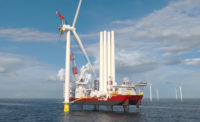Project Finance
European Wind Energy Sector Boosts Project Investor Interest

European investment in wind power fell 11% last year to $43.6 billion compared to 2020, but because most of that was for relatively low cost onshore, the 24.6 GW total financed was a record for a single year, says a new report by the Brussels-based trade group WindEurope.
Wind energy remains an attractive investment, "and there is plenty of capital available to finance it," the Brussels-based group says. However, governments must ease permitting procedures if carbon reduction targets are to be met, it adds. While European Union countries need to install 30 GW a year, they achieved only 19 GW in 2021.
Offshore projects totalling 4.8 GW of new capacity attracted $17.5 billion of investment last year, says WindEurope. It was concentrated in the UK, with $9.3 billion financed, followed by Germany at $5.2 billion, France at $2.3 billion and Denmark, $738 million. At $3.7 million per MW, the average capital cost of offshore wind was 2.7 times greater than for onshore.
Off balance sheet, non recourse financing covered 56% of the offshore wind investment and 26% of the total for onshore. For projects using project finance, offshore investments included, on average. 22% equity, double than that for onshore, WindEurope says.
Meanwhile, at the group's annual meeting last month in Bilbao, Spain, 25 officials representing six countries—Spain, Germany, UK, Belgium, Luxembourg and Estonia—as well as transmission system operators, non-governmental organizations and developers agreed to jointly fast-forward deployment of offshore wind in European waters.
The agreement is aimed to create a regulatory framework that secures a predictable long-term offshore wind market environment and sustainable business models that the industry has sought recently from the European Union. This includes coordinated design of tenders, identifying best practices in national support schemes and developing market parameters for shared offshore "hybrid" systems that distribute costs and benefits between countries, grid operators and project developers.
In addition to its existing target of 60 GW for offshore wind energy by 2030, the EU now calls for another 30 GW in the next decade to help replace a large share of Russian fossil fuel imports.
“Europe urgently needs visibility on offshore wind volumes, a coordinated approach to grid planning and the right regulatory framework for new business models such as offshore hybrids,” said WindEurope CEO Gilles Dickson. "Every time we build offshore wind in Europe, it generates economic drive."






